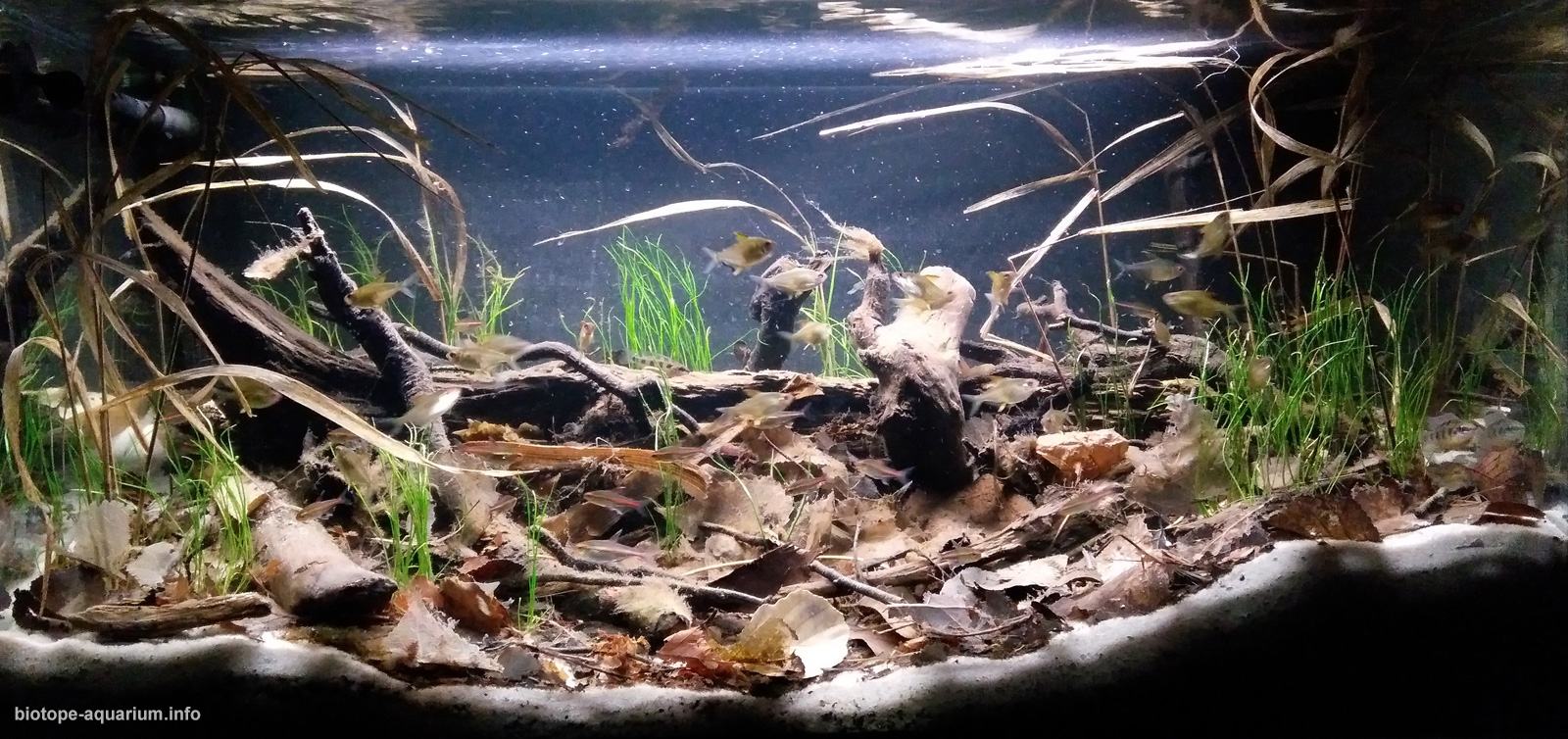Flooded area of Lago Verde on the Tapajós River, Alter do Chão, Brazil
77th place in Biotope Aquarium Design Contest 2018
![]() Czech Republic. Michal Klacek
Czech Republic. Michal Klacek

Volume: 126 L
Dimensions: 80x35x45 cm
List of fishes: Dicrossus maculatus, Hemigrammus erythrozonus, Hyphessobrycon pulchripinnis
List of plants: Lilaeopsis brasiliensis
Description of decorations: On the bottom there is fine sand with a fraction of 0-2 mm. Then I used roots and branches that I took out of the water in nature. The layer of biological material, such as leaves, tree bark, fragments of twigs, also was taken from the riverbed. And as a last detail, dry grass is used to point out the fact that it is a flooded area. In the attached video you can see the natural behavior of Dicrossus maculatus in the search for food. If the aquarium does not contain leaves and other biological material, this behavior will be suppressed.
Description of equipment: external filter JBL Cristal Profi e700, fluorescent lamps Atman 1x 20w T8.
Water parameters: Water temperature is 25°C, conductivity is 40 uS/cm, pH is 6. The water is treated with a reverse osmosis system.
INFORMATION ABOUT BIOTOPE
Description of the area surrounding the biotope: The Verde Lake is located northeast near the town of Alter do Chao. It has beaches with fine white sand, but most of the shores are covered with trees and shrubs, often reaching the water. The water in the lake is greenish-blue, but transparent to a depth of 1.5 m. The lake supplies water to the Tapajós River, which is formed by the confluence of the Juruena and Telis Piris or San Manuel rivers that originate in the highlands of Serra dos Parecis. For most of its length, the Tapajós River passes through the state of Pará. The Tapajós River is about 1930 km long and with an average flow of 13 m3/s it is one of the largest tributaries of the Amazon. The Tapajós River was named after an extinct group of indigenous peoples. In the rainy season, which is from November to March, the Tapaios River level reaches 7-8 m, resulting in a rise in the Verde Lake and the flooding surrounding forests and vegetation. This is used by most fishes to spawn. The lake is surrounded by a lot of vegetation and among the most frequently represented trees are Leguminosae, Couepia paraensis, Leopoldinia pulchra.
Description of the underwater landscape of the biotope: In the Verde Lake you can see a clean, sandy bottom, free of sludge, sediment, wood and other biological material, and the bottom covered with a layer of leaves, dead plant remains and lots of roots, tree trunks and branches. During rains and floods, a lot of flooded grasses and other terrestrial or muddy plants can be seen in combination with wood, leaves, algae and sediment.
Description of the parameters of the habitat: The water in the Verde Lake is clear with blue-green tinge, pH fluctuates according to season from 5 to 7, conductivity also varies depending on the season in the range of 10-25 μS/cm, temperature is 23-27°C.
List of fishes and invertebrates occurring in the nature biotope: Pristella maxillaris, Hyphessobrycon heliacus, Nannostomus eques, Nannostomus bifasciatus, Hemigrammus sp., Leporinus fasciatus, Dicrossus maculatus, Hemigrammus erythrozonus, Hyphessobrycon pulchripinnis, Crenicichla regani, Apistogramma sp, Mesonauta festivum, Uaru amphiacanthoides, Crenicichla sp., Geophagus sp. and lots of other fishes.
List of plants found in the nature biotope: Lilaeopsis braziliensis in marginal parts. There is also a grass that forms a dense carpet that I cannot name.
Threats to the ecology: Life in the Tapajós River can be greatly damaged, if the Brazilian government gives permission to build several dams. These waterworks would result not only in the flooding of indigenous areas, which would be undesirable to local residents, but also in the overall calming of the flow and destruction of today’s waterfalls and rapids, which some fish species might not survive, if they live in a symbiosis with this environment. This whole project meant to be created for improving ship navigability, and this would be another environmental problem. All this is done only to transport soy beans from Mato Grosso to Amazon river ports. So let’s hope the Brazilian government will have enough reason not to destroy this unique river.
Sources of information:
- http://www.reef2rainforest.
com/2017/01/30/biotope-video- clearwater-creeks-on-the- lower-tapajos/ - https://www.researchgate.net/
publication/263103130_ Structure_and_species_ richness_of_low-diversity_ floodplain_forest_on_the_Rio_ Tapajos_Eastern_Amazonia_ Brazil - https://en.wikipedia.org/wiki/
Tapaj%C3%B3s - http://www.reef2rainforest.
com/2017/01/30/biotope-video- clearwater-creeks-on-the- lower-tapajos/ - https://www.witpress.com/
Secure/elibrary/papers/WS13/ WS13002FU1.pdf
